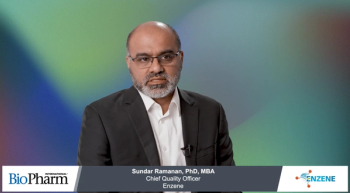
Ask the Expert: Key Considerations for Building Sustainable Cleanrooms
Steve Griffiths, Global VP of Business Development at GCS, discusses the essential environmental factors involved in cleanroom construction. Viewers will gain insight into the decisions that influence sustainability from selecting materials to optimizing energy use.
A cleanroom is imperative for keeping airborne particulates and other sources of contamination away from sensitive work like pharmaceutics, nuclear power, the semiconductor industry, among others. To make sure a cleanroom is successful, the environment plays a critical role. In this Ask the Expert program, BioPharm International sat down with Steve Griffiths, Global VP of Business Development at GCS, to highlight the environmental factors crucial to cleanroom design. From reducing embedded carbon and improving energy efficiency to understanding Environmental Product Declarations (EPDs), practical strategies are given for sustainable construction. The discussion also looks ahead to future trends in carbon measurement and transparency for cleanroom projects.
BioPharm International: Thank you so much for joining us today, Steve.
Steve Griffiths: Thanks, really good to be here. I've spent 10 to 15 years in the cleanroom construction industry now and got a very personal passion for things that impact the environment.
I've always enjoyed nature since being a young child and I've seen a few things lately that have really pushed home how important the work we do is and its impact on the environment. So really good to talk about this subject and look forward to reflecting on my learnings from our factory in College Station, Texas and the slight nuances and differences that we have in our European factory in France to open a discussion on the environmental impact of clean room design and build.
BioPharm International: What are the key environmental decisions to consider when building a cleanroom?
Griffiths: Building a clean room is very similar to most construction buildings that you'll make. You've got a few different considerations. There's the operational carbon once the building is live, which is significant in a cleanroom because there's quite high energy usage with a large number of air changes, etc.
You're running energy, you're running cost as well. Then there's also the consideration to be made for the embedded carbon within the building construction itself and the build. Many people forget this embedded carbon, but depending on the materials used during the construction phase and the amount of people used to build the building, it can be significant. Different methods have very different embedded carbon factors when considering clean room builds.
BioPharm International: How can buyers ensure that they reduce the embedded carbon in these new cleanroom builds, especially when you're saying that sometimes they don't even know how much is there?
Griffiths: Ultimately it would come under the category of sustainable sourcing. We should consider the materials used. As I said, there's recycled materials, there's non-recyclable materials, there's materials such as concrete that is very carbon heavy. Another carbon heavy product is steel. Having worked in the steel industry for ten years, I can tell you there's a huge range within steel construction on sustainably manufactured steel and non-sustainably manufactured steel. Very common today is to build your clean rooms and your hygienic environments using steel faced panels like we manufacture at GCS.
It is important to challenge the manufacturer to make sure they're sourcing sustainably using steel that comes from recycled and renewable sources and that it's made in such a way also that it can be recycled at end of life. For example, our panels are 98% metal and can be recycled at the end of life using a scrap steel process. These are important decisions.
Ultimately, it's important that these are fact and science-based decisions that the embedded carbon that you think you're building your construction with is not just greenwashing, as we'd say, or perception. And you use some tools and some methods to get scientific calculations on the real embedded carbon in every material used. The most common way across the world and the universally accepted way to measure this is using an EPD, which stands for Environmental Product Declaration.
BioPharm International: What exactly is an environmental product declaration and how is it generated?
Griffiths: An EPD is basically an assessment of the product's lifecycle environmental impact. There are international standards such as ISO 14025 that are used to make sure that everyone's doing it in the same way. There's different categories and stages that your material will be measured on.
So, the phrase I'm familiar with is cradle-to-grave measurement of the carbon within the product. After this point, it can be publicly registered for assessment by a third-party. That's also important that we've got third-parties holding this to account and measuring the EPD in the same way.
Typically, an EPD would be valid for about five years, but if there's a significant change to anything within the way a product is made, the EPD should be redone. For example, at GCS, we're just redoing some of our EPDs now because we've sourced a more sustainable type of steel that we'll use going forward. We want our EPDs to reflect this improvement.
The other part of the EPD process is each product category would be put into rules. So, your concrete, your structural steel, your panel will all have different rules on the completion of the EPD. These EPDs help us understand fully and communicate that environmental impact, share it with clients, and ultimately make a calculation on the full embedded carbon within the construction of that building.
BioPharm International: As we're talking about EPDs, why are they so meaningful to customers? How can manufacturers drive improvements?
Griffiths: If I pick up on the first part of that question as to why they're meaningful. Our industry is heavily around health and pharmaceuticals, etc. If we're not taking care of the environment and we're setting up an environment that's not helpful to health, then we're kind of creating a bit of an oxymoron in the work that we're doing. So, it's really important that we're building these facilities in a sustainable way. For manufacturers like GCS, it's important to measure the energy usage. One thing we do is we have annual carbon accounting.
This comes in a few phases. It measures our operational energy as a manufacturer, something that we're always driving to reduce by use of sustainable energy, renewably driven fleet vehicles, etc. That covers scope 1 and 2 emissions.
What would be considered scope 3 emissions within carbon accounting are your supply chain. This usually, for a manufacturer like us, accounts for about 90% of the overall embedded carbon in the product. So, it's really important to drive your supply chain like I've already touched on. Locally sourced really helps. Making sure that our suppliers are also using the best packaging materials, the best way of getting the goods to us, and lowering their own operational energy. Aluminium extrusion, steel manufacture, are really carbon-heavy industries. The best is a lot different to the worst. So, it's important that you drive it through everything within your culture, reducing your internal carbon, and reducing that of your supply chains.
BioPharm International: How might future developments in measuring embedded carbon look like?
Griffiths: For a good number of years now, we've been improving our digital modeling of the sort of facilities that we fabricate the components for. I see a world where, in the future, we're using these digital models, embedding EPDs, and during the digital model phase, it's creating a full life cycle for your facility, including the embedded carbon and the operational carbon. Also, I'm sure there'll be a world where AI can support us to generate heat maps for maybe where the worst culprits are for embedded carbon within the cleanroom.
Looking at full databases of EPDs, make suggestions on how we could maybe trade in different components to improve the environmental impact of our facilities as this becomes more and more prevalent over the coming years.
Newsletter
Stay at the forefront of biopharmaceutical innovation—subscribe to BioPharm International for expert insights on drug development, manufacturing, compliance, and more.





